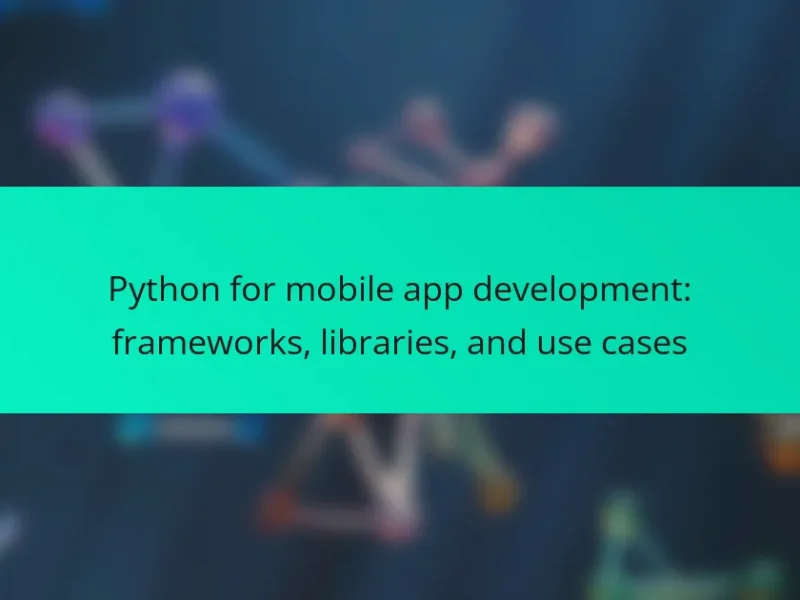Ruby on Rails is a web application framework written in Ruby, specifically designed for developing database-backed web applications using the Model-View-Controller (MVC) architecture. This article explores the advantages of using Ruby on Rails for mobile app backends, highlighting essential gems such as Devise for authentication, Active Model Serializers for efficient JSON handling, and Pundit for authorization. It also discusses deployment strategies, including the use of cloud platforms, containerization, and continuous integration/continuous deployment (CI/CD) practices, which enhance performance and reliability. Overall, Ruby on Rails offers a streamlined development process, making it a popular choice for startups and projects requiring rapid deployment.

What is Ruby on Rails and how is it used for mobile app backends?
Ruby on Rails is a web application framework written in Ruby. It is designed to facilitate the development of database-backed web applications. Ruby on Rails follows the Model-View-Controller (MVC) architecture. This structure separates application logic, user interface, and data management.
For mobile app backends, Ruby on Rails serves as a robust server-side technology. It handles data processing, business logic, and API creation. Developers use Rails to build RESTful APIs that mobile applications can communicate with. This allows mobile apps to retrieve and send data efficiently.
Rails provides built-in tools for database management and routing. It also supports various gems that enhance functionality. Gems like Devise for authentication and ActiveModelSerializers for JSON rendering are commonly used. These tools streamline development and improve app performance.
The framework’s convention over configuration principle accelerates the development process. This reduces the amount of code developers need to write. Consequently, Ruby on Rails is a popular choice for startups and projects requiring rapid development.
How does Ruby on Rails facilitate mobile app development?
Ruby on Rails facilitates mobile app development by providing a robust framework for building APIs. It allows developers to create backends quickly using conventions and built-in tools. Rails includes features like RESTful routing and Active Record for database management. These features streamline the development process and reduce the amount of code required. Additionally, Rails has a rich ecosystem of gems that enhance functionality. Gems like Devise for authentication and Active Model Serializers for JSON responses simplify common tasks. This efficiency accelerates the overall development timeline. Furthermore, Rails supports rapid prototyping, enabling teams to iterate on mobile app features quickly.
What are the core features of Ruby on Rails that support mobile backends?
Ruby on Rails offers several core features that support mobile backends. Its RESTful architecture facilitates the creation of APIs, enabling seamless communication between mobile apps and servers. The framework’s Active Record simplifies database interactions, allowing for efficient data management. Built-in support for JSON responses enhances data exchange formats preferred by mobile applications. Rails also provides a robust routing system, which helps manage URL structures effectively. Furthermore, its middleware support allows for easy integration of third-party services. Security features, such as built-in protection against SQL injection and cross-site scripting, ensure safe data handling. These features collectively enhance the development and performance of mobile backends using Ruby on Rails.
How does Ruby on Rails compare to other backend frameworks for mobile apps?
Ruby on Rails offers rapid development and convention over configuration, making it efficient for mobile app backends. It emphasizes simplicity and productivity, allowing developers to build applications quickly. Compared to other frameworks like Node.js or Django, Rails has a strong emphasis on convention, which can reduce development time. However, Node.js provides non-blocking I/O, which can lead to better performance for real-time applications. Django, on the other hand, is known for its robust security features and scalability. Rails has a rich ecosystem of gems, enhancing functionality, but may have slower performance in high-traffic applications compared to Node.js. Overall, Rails excels in development speed and ease of use, while other frameworks may offer better performance or specific features.
What are the advantages of using Ruby on Rails for mobile app backends?
Ruby on Rails offers several advantages for mobile app backends. It provides rapid development due to its convention over configuration approach. This framework allows developers to create applications quickly, reducing time to market. Ruby on Rails has a rich ecosystem of gems that extend functionality. These gems simplify common tasks, enhancing productivity. The framework is built on the MVC architecture, promoting clean code and separation of concerns. This structure makes it easier to maintain and scale applications. Additionally, Ruby on Rails emphasizes testing, ensuring high code quality. The community support is robust, offering numerous resources and libraries. Overall, these factors contribute to Ruby on Rails being a strong choice for mobile app backends.
How does Ruby on Rails enhance development speed and efficiency?
Ruby on Rails enhances development speed and efficiency through convention over configuration and built-in tools. The framework reduces the amount of code developers need to write. It allows for rapid prototyping and development of applications. Rails includes a vast library of gems that provide pre-built functionalities. These gems streamline the integration of features and save time. The framework’s scaffolding feature generates basic code automatically. This automation accelerates the setup of new applications. Additionally, Rails follows the DRY (Don’t Repeat Yourself) principle, minimizing redundancy. These characteristics collectively contribute to faster development cycles and improved productivity.
What are the cost benefits associated with using Ruby on Rails for mobile app backends?
Using Ruby on Rails for mobile app backends offers significant cost benefits. Development speed is enhanced due to Rails’ convention over configuration approach. This reduces the amount of code developers need to write. The framework’s extensive library of gems accelerates feature implementation. Consequently, projects can be completed faster, lowering labor costs.
Ruby on Rails also promotes code reusability. This allows developers to leverage existing codebases across multiple projects. Maintenance costs are minimized due to the framework’s clear structure. Additionally, the active community provides support and resources, reducing troubleshooting time.
Overall, these factors contribute to a more cost-effective development process. Studies show that companies using Ruby on Rails can see a 30% reduction in development time compared to other frameworks. This efficiency translates directly into savings on project budgets.
Why is community support important for Ruby on Rails users?
Community support is crucial for Ruby on Rails users because it fosters collaboration and knowledge sharing. This support network helps developers troubleshoot issues and improve their coding skills. Access to community resources, such as forums and documentation, enhances learning and problem-solving capabilities. According to the Stack Overflow Developer Survey, over 60% of developers rely on community forums for assistance. Additionally, open-source contributions from the community lead to the continuous improvement of the Ruby on Rails framework. This collaborative environment encourages innovation and keeps the technology up-to-date with industry standards.
How does the Ruby on Rails community contribute to its ecosystem?
The Ruby on Rails community contributes to its ecosystem through collaboration, open-source contributions, and knowledge sharing. Community members actively develop and maintain numerous gems that extend Ruby on Rails functionality. There are over 160,000 gems available, which enhance the framework’s capabilities. The community organizes events like RailsConf and meetups to foster networking and learning. Online forums and platforms, such as Stack Overflow, provide support and resources for developers. This collaborative environment encourages innovation and best practices within the framework. Additionally, the community contributes to documentation and tutorials, making it easier for newcomers to adopt Ruby on Rails. These efforts collectively strengthen the Ruby on Rails ecosystem and promote its growth.
What resources are available for developers using Ruby on Rails?
Developers using Ruby on Rails have access to a variety of resources. Key resources include the official Ruby on Rails documentation, which provides comprehensive guides and API references. Community forums like Stack Overflow offer peer support and troubleshooting advice. Online courses from platforms like Udemy and Codecademy teach Ruby on Rails fundamentals. Additionally, GitHub hosts numerous open-source projects that developers can explore and contribute to. Books such as “Agile Web Development with Rails” serve as valuable learning materials. Finally, Ruby on Rails conferences and meetups facilitate networking and knowledge sharing among developers.

What are the essential Ruby on Rails gems for mobile app development?
The essential Ruby on Rails gems for mobile app development include Devise, Active Model Serializers, and Pundit. Devise provides flexible authentication solutions for user management. Active Model Serializers enables efficient JSON serialization for APIs, crucial for mobile apps. Pundit offers a simple way to handle authorization in Rails applications. These gems enhance security, data handling, and user access control, making them vital for mobile backend development.
Which gems are most commonly used in Ruby on Rails for mobile backends?
The most commonly used gems in Ruby on Rails for mobile backends include Devise, ActiveModel Serializers, and Pundit. Devise provides flexible authentication solutions, making it a popular choice for user management. ActiveModel Serializers facilitates the serialization of data, ensuring that APIs return data in a structured format. Pundit offers a simple way to handle authorization, ensuring users have appropriate access to resources. These gems enhance the functionality and security of mobile backends built with Ruby on Rails.
What functionalities do these gems provide for mobile app development?
Gems provide various functionalities for mobile app development in Ruby on Rails. They offer libraries that simplify tasks like authentication, API integration, and database management. For instance, gems like Devise enable user authentication with minimal configuration. ActiveModel Serializers help format JSON responses for APIs, enhancing data exchange. Additionally, gems like Paperclip facilitate file uploads, allowing users to attach images or documents easily. Other gems, such as Pundit, manage user authorization effectively. These functionalities streamline development processes, saving time and reducing complexity. Overall, gems enhance the efficiency and scalability of mobile app backends in Ruby on Rails.
How can developers choose the right gems for their projects?
Developers can choose the right gems for their projects by evaluating their specific needs. They should consider the functionality required for the application. Checking the gem’s popularity and community support is essential. Popular gems often have better documentation and more frequent updates. Developers should also review the gem’s compatibility with their Ruby on Rails version. Reading user reviews and issues on repositories can provide insights into performance and reliability. Additionally, testing the gem in a development environment helps assess its fit for the project. Finally, analyzing the gem’s maintenance history can indicate its long-term viability.
How do these gems enhance the performance of mobile apps?
Gems enhance the performance of mobile apps by providing optimized libraries and tools. They streamline development processes by offering pre-built functionalities. This reduces the amount of code developers need to write. Gems like ‘Kaminari’ improve pagination efficiency. ‘Devise’ enhances authentication processes securely and quickly. Using gems can lead to reduced load times by optimizing database queries. The integration of caching gems can significantly decrease server response times. Overall, utilizing gems allows for more efficient resource management in mobile app development.
What are the best practices for integrating gems in Ruby on Rails?
Use Bundler to manage gem dependencies in Ruby on Rails. Bundler ensures that the correct versions of gems are installed. Specify gem versions in the Gemfile to avoid compatibility issues. Regularly update gems to benefit from security patches and new features. Test gems in a staging environment before deploying to production. Remove unused gems to maintain a clean and efficient application. Monitor gem performance to identify any potential bottlenecks. Follow gem documentation for proper integration and usage guidelines. These practices enhance application stability and performance.
What challenges might developers face when using gems?
Developers might face compatibility issues when using gems. Different gems may not work well together due to version conflicts. This can lead to unexpected errors and increased debugging time. Additionally, gems can introduce security vulnerabilities if not regularly updated. Developers must also consider the quality and maintenance of the gems they choose. Some gems may be poorly documented, making implementation difficult. Furthermore, relying on external gems can lead to performance issues if they are not optimized. These challenges require careful selection and management of gems to ensure a smooth development process.

What are the best deployment strategies for Ruby on Rails mobile app backends?
The best deployment strategies for Ruby on Rails mobile app backends include using cloud platforms, containerization, and continuous integration/continuous deployment (CI/CD) practices. Cloud platforms like Heroku or AWS offer scalability and ease of use. Containerization with Docker ensures consistency across development and production environments. CI/CD practices automate testing and deployment, reducing the risk of errors. These strategies enhance performance and reliability. According to a study by the Cloud Native Computing Foundation, 77% of organizations use CI/CD to improve deployment frequency and reduce lead time for changes.
What factors should be considered when deploying Ruby on Rails applications?
When deploying Ruby on Rails applications, several factors must be considered. First, the choice of hosting environment is crucial. Options include cloud platforms like AWS or Heroku. Each platform has different scalability and performance characteristics. Next, database management should be addressed. PostgreSQL and MySQL are popular choices, each with unique benefits.
Security is another vital factor. Implementing SSL certificates and adhering to best practices can protect user data. Performance optimization is essential as well. Techniques such as caching and background job processing can enhance application speed.
Additionally, monitoring and logging should be set up. Tools like New Relic or Loggly can help track application health. Finally, deployment automation is beneficial. Utilizing tools like Capistrano or Docker can streamline the deployment process.
How do different hosting services impact Ruby on Rails deployment?
Different hosting services significantly impact Ruby on Rails deployment. They influence performance, scalability, and ease of management. For instance, Platform as a Service (PaaS) options like Heroku simplify deployment with built-in tools. They automate scaling and provide integrated databases, which enhances efficiency. Conversely, Infrastructure as a Service (IaaS) options like AWS require more manual configuration. They offer greater customization but can complicate deployment processes. Hosting services also affect security features. Managed hosting services often include security patches and backups, reducing the burden on developers. Ultimately, the choice of hosting service determines the overall deployment experience and application reliability.
What are the common deployment tools used with Ruby on Rails?
Common deployment tools used with Ruby on Rails include Capistrano, Heroku, and Docker. Capistrano is a remote server automation tool that simplifies deployment tasks. It allows developers to automate the deployment process through scripts. Heroku is a cloud platform that enables easy deployment of Rails applications. It provides a simple interface for managing applications. Docker is a containerization platform that packages applications and their dependencies. This ensures consistent environments across development and production. Each of these tools is widely adopted in the Ruby on Rails community for their efficiency and ease of use.
What are the steps for successfully deploying a Ruby on Rails mobile backend?
The steps for successfully deploying a Ruby on Rails mobile backend include preparing the application, selecting a hosting provider, configuring the server environment, setting up a database, deploying the code, and monitoring the application. First, ensure the application is production-ready by testing and optimizing performance. Next, choose a reliable hosting provider like Heroku or AWS for deployment. Then, configure the server environment with necessary software such as Ruby, Rails, and a web server like Puma. After that, set up a database, typically PostgreSQL, and configure the connection settings. Deploy the code using tools like Capistrano or Git. Finally, implement monitoring tools to track performance and errors. These steps are essential for a successful deployment, as they ensure the application runs efficiently and reliably in a production environment.
How can developers ensure their deployment process is efficient and error-free?
Developers can ensure their deployment process is efficient and error-free by implementing automated testing and continuous integration. Automated testing allows developers to identify bugs early in the development cycle. Continuous integration facilitates frequent code updates, reducing integration issues. Utilizing deployment tools like Capistrano or Heroku can streamline the deployment process. These tools automate repetitive tasks and minimize human error. Additionally, maintaining a robust version control system, such as Git, helps track changes and revert to previous versions if needed. Monitoring tools can also provide real-time feedback on application performance post-deployment. This approach minimizes downtime and enhances user experience.
What monitoring tools can be used post-deployment for Ruby on Rails applications?
Post-deployment monitoring tools for Ruby on Rails applications include New Relic, Datadog, and Skylight. New Relic provides performance monitoring and error tracking. It offers insights into application performance and user interactions. Datadog integrates with various services and provides real-time monitoring. It tracks metrics, logs, and traces across the entire stack. Skylight focuses on performance optimization specifically for Rails applications. It highlights slow endpoints and provides recommendations for improvement. These tools are widely used in the industry for effective monitoring and performance management.
What are the common troubleshooting tips for Ruby on Rails deployments?
Check logs for errors to identify issues during deployment. Logs provide detailed information about failures. Ensure the database is properly migrated and schema is up to date. Run `rails db:migrate` to apply changes. Verify that all environment variables are correctly set. Missing variables can cause application failures. Restart the application server to apply any changes made. Use tools like Puma or Passenger for efficient server management. Monitor server performance and resource usage. High load can lead to slow responses or crashes. Test the application in a staging environment before production deployment. This helps catch issues early. Review application dependencies and ensure they are compatible with the current version of Rails. Outdated gems can cause conflicts.
How can developers resolve performance issues in deployed Ruby on Rails apps?
Developers can resolve performance issues in deployed Ruby on Rails apps by optimizing database queries. This includes using eager loading to reduce N+1 query problems. Additionally, developers should implement caching strategies, such as fragment caching or low-level caching, to minimize database load. Profiling tools like New Relic or Skylight can help identify bottlenecks in the application. Developers can also optimize asset delivery by using tools like Webpacker or Sprockets for efficient asset compilation. Monitoring server performance and adjusting server configurations can further enhance app responsiveness. Regularly reviewing and updating gems can also improve overall performance. These strategies collectively contribute to a more efficient Ruby on Rails application.
What are the best practices for maintaining Ruby on Rails applications post-deployment?
Regularly update Ruby on Rails and its gems to ensure security and performance. Monitor application logs for errors and performance issues. Implement automated testing to catch bugs early. Use performance monitoring tools to identify bottlenecks. Regularly back up databases to prevent data loss. Optimize database queries to improve application speed. Maintain documentation for code and processes to assist future development. Engage in regular code reviews to ensure quality and consistency.
Ruby on Rails is a web application framework used for developing mobile app backends, leveraging its Model-View-Controller architecture for efficient data handling and API creation. The article explores the advantages of using Ruby on Rails, including rapid development, a rich ecosystem of gems for enhanced functionality, and effective deployment strategies. Key gems such as Devise and Active Model Serializers are highlighted for their roles in authentication and data management. Additionally, the article addresses deployment best practices and monitoring tools essential for maintaining Ruby on Rails applications post-deployment, ensuring optimal performance and security.


